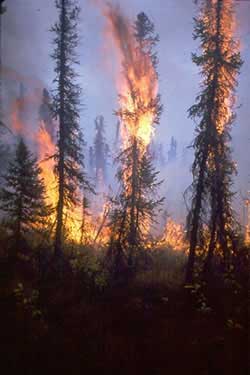Wildland Fire Use
Wildland Fire Use
In some cases, when outlined in a fire management plan and where communities are not at risk, allowing natural fires to burn (wildland fire use) may be the most appropriate management response. In rugged, steep, or highly inaccessible terrain where people are not threatened, wildland fire use can help avoid putting firefighters at unreasonable risk.
Wildland fire use (WFU) is the management of naturally ignited wildland fires (those started by lightning or lava) to accomplish specific resource objectives within a pre-defined area. Objectives can include maintenance of healthy forests, rangelands, and wetlands, and support of ecosystem diversity. Monitoring is a high priority in WFU to ensure the fire stays within boundaries and meets objectives.
Wildland fire use is often a long-duration event which can last weeks or months and may involve temporary inconveniences regarding smoke, travel, and potential closure of public use areas. For this reason, WFU occurs primarily in remote and undeveloped areas, such as wilderness areas on national wildlife refuges in Alaska and other states. The U.S. Fish & Wildlife Service is expanding wildland fire use on its lands to gain resource benefits that can only be achieved with fire.
Trees torch within wilderness at Tetlin NWR in Alaska. Wildland fire use in wilderness and other remote areas is often the most appropriate management response.
Current FWS Wildland Fire Use Plans
Name of Unit |
State |
Region |
Number of Burnable Acres |
WFU Plan |
| San Andres NWR | NM |
2 |
57,215 |
Yes |
| Seney NWR | MI |
3 |
88,639 |
Yes |
| Browns Park NWR | CO |
6 |
13,276 |
Yes |
| Kenai NWR | AK |
7 |
1,352,000 |
Yes |
| Tetlin NWR | AK |
7 |
645,000 |
Yes |
| Yukon Flats NWR | AK |
7 |
8,757,000 |
Yes |
| Okefenokee NWR | GA |
4 |
394,785 |
Yes |
| Arctic NWR | AK |
7 |
14,624,000 |
Pending |
| Innoko NWR | AK |
7 |
3,438,000 |
Pending |
| Kanuti NWR | AK |
7 |
1,381,000 |
Pending |
| Koyukuk NWR | AK |
7 |
1,381,000 |
Pending |
| Nowitna NWR | AK |
7 |
6,450,000 |
Pending |
| Selawik NWR | AK |
7 |
2,100,000 |
Pending |
History of WIldland Fire Use
Wildland fire use is a relatively new wildland fire management action. It was originally termed as prescribed natural fire and initiated by the National Park Service (NPS) in 1968. Prescribed natural fire grew slowly in the Park Service and in the U.S. Forest Service during the 1970s and 1980s. The 1995 Federal Wildland Fire Management Policy renamed prescribed natural fire to wildland fire use and documented the need to increase these types of actions in response to wildfire. Since 1995, wildland fire use has increased dramatically.
During the 1970s, for example, there were prescribed natural fire programs in California, Arizona, Idaho, Montana, Wyoming, Colorado, and Florida. By 2001, wildland fire use had expanded to include those states, plus Washington, Oregon, North Dakota, South Dakota, Minnesota, Michigan, Utah, Nevada, New Mexico, Texas, Arkansas, Kentucky, Tennessee, Alaska, and Georgia.

